|
Russia's Miraculous Icons
by
Bob Brooke
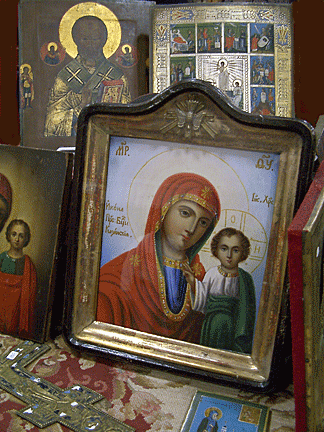 “Behold,
a virgin shall conceive, and bear a son, and shall call his name
Immanuel.” As Our Lady of Vladimir raises up her hands with a powerful
gesture in a prayer of intercession, the Russian people receive the
blessing of God's eternal Word through an icon bearing her image. And so
it has been for 10 centuries. “Behold,
a virgin shall conceive, and bear a son, and shall call his name
Immanuel.” As Our Lady of Vladimir raises up her hands with a powerful
gesture in a prayer of intercession, the Russian people receive the
blessing of God's eternal Word through an icon bearing her image. And so
it has been for 10 centuries.
Like all other peoples that embraced Byzantine Christianity in the
Middle Ages, the Russians realized that an icon was essentially both a
devotional image and a work of art.
Icon comes from the Greek word iekon, meaning “image.” The
Russian Orthodox Church regards icons as the images of the personages
and scenes of god’s heavenly kingdom on Earth. Icons, which depict in
graphic form the people, events, and moral truths of the Bible, were
essential to the early Church as a teaching tool for the illiterate
population much as religious paintings were to Western art. More
importantly, portrayal of the sacred images of Christ, Mary, and the
saints were a means of leading the population to worship.
Believers regard the image represented in an icon as a true likeness.
Naturally, this view came to influence the structure of the composition.
Though in later times iconographers painted them on metal, they painted
the majority of icons on wood. The form originated from the tomb
portraits of ancient Egypt. The Byzantines perfected the technique,
transforming the old medium into something wholly Christian.
Early Icons
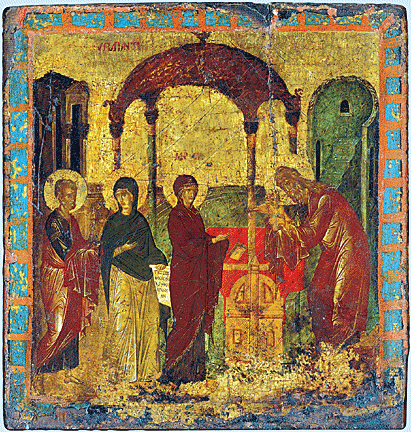 Russian
iconographers created the earliest icons during the 10th century,
following examples imported from Constantinople a century earlier by
Vladimir, Great Prince of Kiev Rus, who adopted the Greek Orthodox form
of Christianity as the official religion of his country. These Byzantine
faces revealed deeply soulful gazes which riveted the gaze of viewers.
But later portraiture drew from a more Western style which gave a
contemplative and more gentle appearance. By the 17th century, the
Russians had made significant changes to the style and intent of the art
form. Russian
iconographers created the earliest icons during the 10th century,
following examples imported from Constantinople a century earlier by
Vladimir, Great Prince of Kiev Rus, who adopted the Greek Orthodox form
of Christianity as the official religion of his country. These Byzantine
faces revealed deeply soulful gazes which riveted the gaze of viewers.
But later portraiture drew from a more Western style which gave a
contemplative and more gentle appearance. By the 17th century, the
Russians had made significant changes to the style and intent of the art
form.
During the 13th century, Kievan Rus had collapsed under the invasion of
the Mongols. Because of the constant threat of raids by the Tartars, the
merchant city of Novgorod, far to the north of Kiev, became
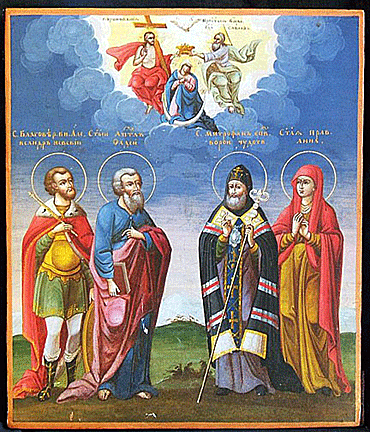 Russia’s
cultural center for the next three centuries. The icons produced
there—using long-established iconographic schemes, transparent,
brilliant colors, a striving for naturalism and an avoidance of
exaggerated formality—pictured the patron saints of fields, forests,
herds and commerce. Russia’s
cultural center for the next three centuries. The icons produced
there—using long-established iconographic schemes, transparent,
brilliant colors, a striving for naturalism and an avoidance of
exaggerated formality—pictured the patron saints of fields, forests,
herds and commerce.
By the second half of the 15th century, Czar Ivan III ruled and Moscow
once again became the center of the Russian empire causing the Moscow
School of painting to become as important as the capital.
Devotional icons commissioned by an
individual or household tended to be more elaborately decorated than
church icons. Often these works featured a saint that held particular
relevance to the family.
In Moscow, wealthy Moscovites demanded smaller icons to use in their
small private chapels. They could afford to own personal icons, so it
became popular for them to place an icon in the far right-hand corner of
each bed in their homes. Icons came to be regarded as intimate friends
of the family, and this change resulted in a simpler designs.
The Novgorod and Moscow Schools
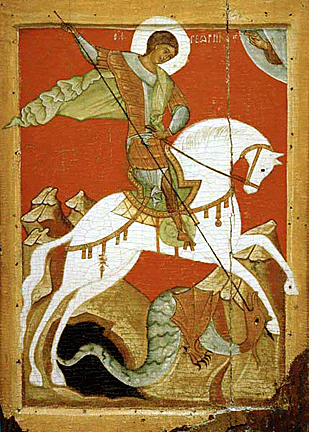 At
first the main difference between the Novgorod and Moscow Schools was
one of mood. But Moscow’s icon painters, who had been previously
concerned with the emotional and spiritual content of their paintings,
began to strive for specific pictorial quality. Thus, Moscow icons tend
to be more pleasing and decorative, if less intense and spiritual, than
those of the Novgorod School. At
first the main difference between the Novgorod and Moscow Schools was
one of mood. But Moscow’s icon painters, who had been previously
concerned with the emotional and spiritual content of their paintings,
began to strive for specific pictorial quality. Thus, Moscow icons tend
to be more pleasing and decorative, if less intense and spiritual, than
those of the Novgorod School.
For instance, the arrangement of subjects within an icon could take the
form of a view from above, which eliminates overlapping and so enables
viewers to recognize all persons and objects depicted. Thus, the
faithful are somehow drawn into the icon and enter a kind of dialogue
with it.
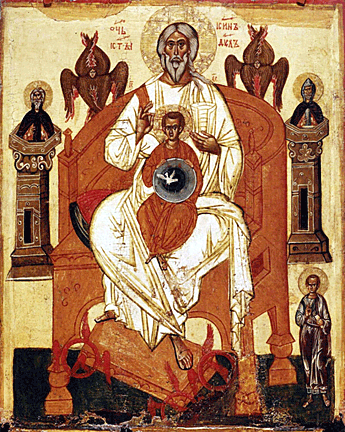 Another
compositional scheme made use of what’s called relative or “ranking”
perspective, in which the most important figures appeared larger in the
foreground and the least important ones smaller in the background.
Iconographers not only worked out the proportions of a figure’s head and
face but also its body. Another
compositional scheme made use of what’s called relative or “ranking”
perspective, in which the most important figures appeared larger in the
foreground and the least important ones smaller in the background.
Iconographers not only worked out the proportions of a figure’s head and
face but also its body.
Originally, iconographers produced icons for use in churches and for
carrying in processions, the latter type generally painted on both sides
of the board. These early icons were large, but with the introduction of
the iconostasis or icon stand by the Russians in the 14th century, they
became smaller.
The iconostasis served both as a screen separating the body of the
church from the apses in which the altar stood. From its inception,
tradition defined the place of an icon on an iconostasis–the icons in
the main or first row always being larger than the others.
Collecting Russian Icons
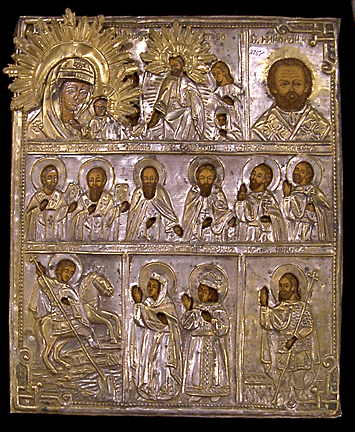 By
the 1830s, interest in both Byzantine and Russian icons had become
common. Wealthy merchants began to collect icons for their artistic
merit, forming collecting societies and causing the prices of old icons
to rise substantially. By
the 1830s, interest in both Byzantine and Russian icons had become
common. Wealthy merchants began to collect icons for their artistic
merit, forming collecting societies and causing the prices of old icons
to rise substantially.
Of course, interest in collecting any art object brings out the
enterprising spirit. In the 1880s, a photographer persuaded the
religious authorities of the Caucasus, where many ancient monasteries
survived, to allow him to replace the worn and dirty icons preserved in
their churches with shiny, new ones. In doing so, he acquired some early
works which he then sold for high prices. The authorities in St.
Petersburg promptly stopped him, but his dealings had a stimulating
effect on the religious art market, so icon collecting began in earnest.
Creating an Religious Icon
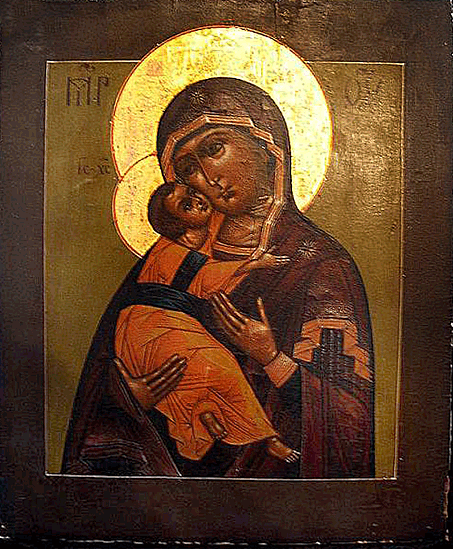 Unlike
the medieval painters in the West, icon painters very rarely used
contemporary models for sacred personages. Each of their saints had
distinct, individual features, which had become standardized through the
centuries. In the 17th century, the Russian Orthodox Church extended
this concept to the icon portraits of persons who hadn’t been canonized. Unlike
the medieval painters in the West, icon painters very rarely used
contemporary models for sacred personages. Each of their saints had
distinct, individual features, which had become standardized through the
centuries. In the 17th century, the Russian Orthodox Church extended
this concept to the icon portraits of persons who hadn’t been canonized.
Preparing a board for the painting of an icon was complicated. To begin
with, the surface of the panel had to be smoothed and its back had to be
strengthened by the insertion of wedges into specially cut slats. Then
the front of the board had to be covered with a layer of gesso, which to
some extent corresponded to the plaster surface of a wall. Some
iconographers covered this with a layer of canvas, which they rubbed
into the gesso and then overlaid it with another thin layer of gesso.
When the gesso had hardened, it had to
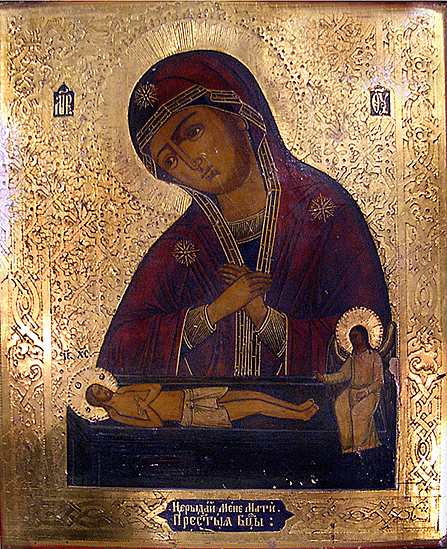 be
polished to form a smooth, shiny surface onto which the icon painters
sketched in the outline of the picture in red paint. These outlines kept
very close to tradition as laid down in a body of tracings called
Podliniki or “Authorised Versions,” assembled into manuals for the use
by the painters. be
polished to form a smooth, shiny surface onto which the icon painters
sketched in the outline of the picture in red paint. These outlines kept
very close to tradition as laid down in a body of tracings called
Podliniki or “Authorised Versions,” assembled into manuals for the use
by the painters.
Next painters applied the background, usually choosing golf leaf, though
the Moscow painters often preferred silver or red, while the Novgorod
painters favored a white ground. Only when the background had dried
could the painter execute the actual scene, doing so with colors which
he diluted with egg yolk to give them brilliance and opacity.
Red was a favorite color of the icon painters of Novgorod and Northern
Russia. The painters of the Novgorod School favored bright, direct light
rather than the subdued, indirect light of the Byzantine painters.
Today, this marks the distinct difference between icons of the Russian
and Greek Orthodox Churches.
Colors of Icons
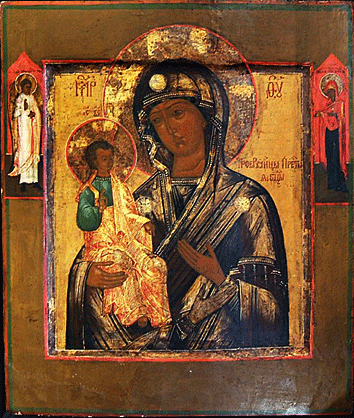 Traditionally,
Russian iconographers painted their icons in layers. They first applied
a dark brown background color as the first layer, upon which they
painted the saint’s features in a reddish ochre and light brown with
light areas and highlights completed in an ochre mixed with white lead.
Highlights on an icon weren’t depictions of gleams of light, invoked to
create the illusion of rounded form, but a strict system that invoked
the symbolic incarnation of the emanation of divine energy, which poured
into the world, giving it life and meaning. Traditionally,
Russian iconographers painted their icons in layers. They first applied
a dark brown background color as the first layer, upon which they
painted the saint’s features in a reddish ochre and light brown with
light areas and highlights completed in an ochre mixed with white lead.
Highlights on an icon weren’t depictions of gleams of light, invoked to
create the illusion of rounded form, but a strict system that invoked
the symbolic incarnation of the emanation of divine energy, which poured
into the world, giving it life and meaning.
They also emphasized the saint’s eyes with a deep shaded orbit and a
shining point in the center and thick eyebrows, lashes, and eyelids.
They didn’t use an shades of gray as they fell between black and white,
or good and evil. Russian iconographers considered gray a color of
uncertainty and emptiness.
The Lack of Depth in Icon Painting
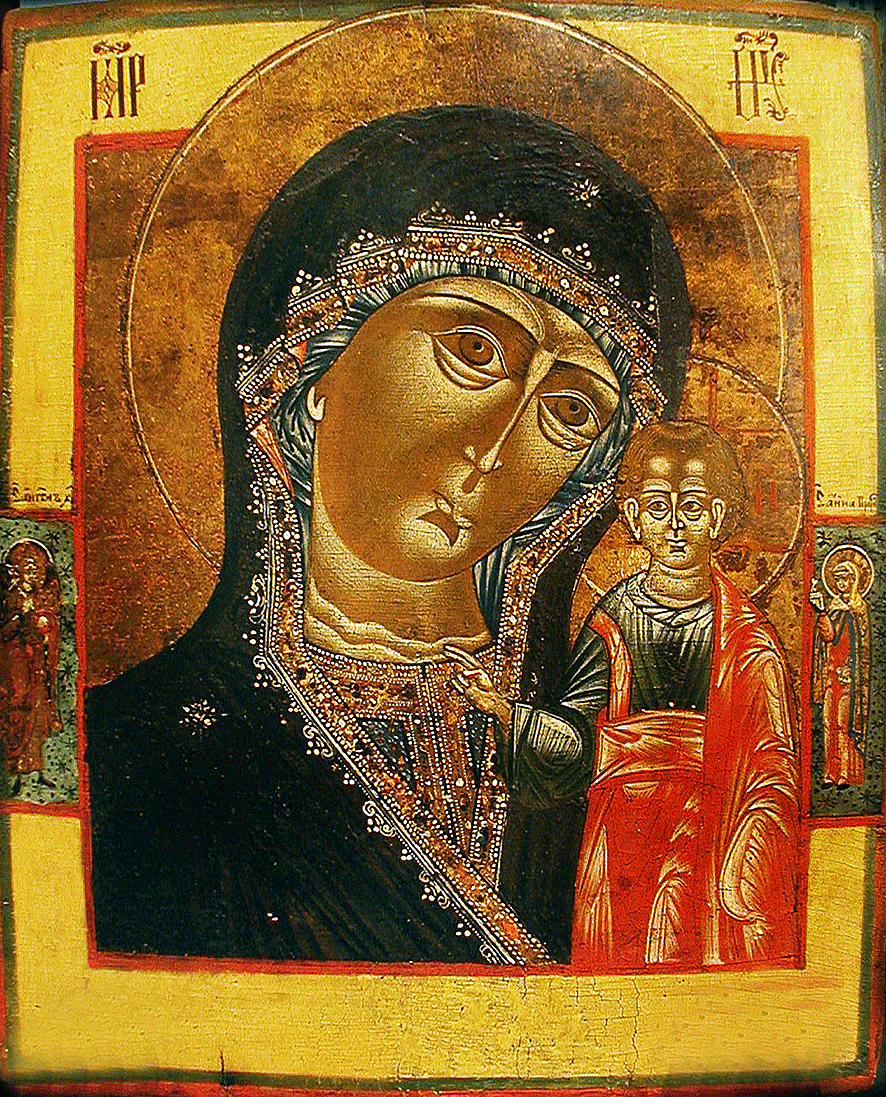 Characteristically,
icons depicted only the bust of the saint facing the worshiper. This
convention is identical to Ancient Egyptian funerary portraiture. Any
clothing on display would suggest the saint’s calling in life,
especially if they had been a member of clergy. Characteristically,
icons depicted only the bust of the saint facing the worshiper. This
convention is identical to Ancient Egyptian funerary portraiture. Any
clothing on display would suggest the saint’s calling in life,
especially if they had been a member of clergy.
Russian iconography was also subject to “The Canon,” which ensured
consistency among iconographic images. Often, painters would use a
tracing tool and guidebooks with detailed descriptions of each saint. As
such, even small details like the shape of their beard or clothing color
helped viewers to interpret the image. Hands raised in blessing or in
prayer were often popular poses and imbued the paintings with further
religious undertones.
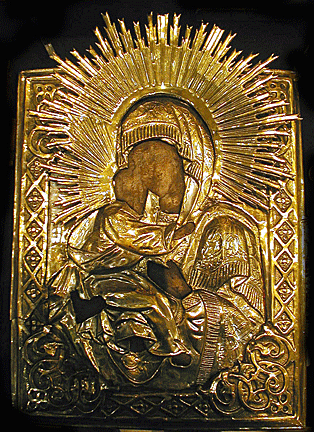 Christ,
the Virgin Mary, and other Heavenly figures would often be depicted with
a circular halo, which was considered the most divine form. Christ,
the Virgin Mary, and other Heavenly figures would often be depicted with
a circular halo, which was considered the most divine form.
The Use of Revêtements
Influenced by Greek art, Russian iconographers began to cover their
figures with plates of silver and gold to create the relief of fabrics
as early as the 14th century. This technique, known as Revêtement,
featured areas of uncovered skin and hair left to show through holes in
the metal, which would often be worked with a technique called repoussé
niello, or inlaid designs filled with a black mixture usually made from
copper or sulfur.
Icon Motifs
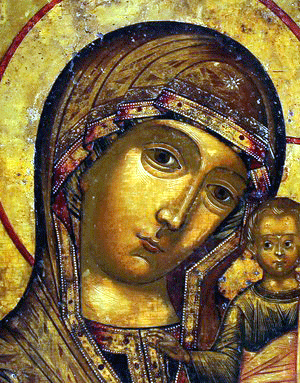 Also,
the faces painted by the Russians have a somewhat more natural oval and
a less stern expression than the Greek ones. The skin tones are usually
ochre-colored, while the modeling was produced by using paler tones of
the same shade to pick out the highlights, which often took the form of
two tiny, white, parallel strokes. The bodies are stockier and less
elegant, with a flatter look about them, due to the absence of the
modeling which is characteristic of Byzantine art. On the other hand,
Byzantine outlines are more definite, more linear and more succinct, and
the impact they make is sharper because of the elimination of
unessential details. Generally, the subjects of Russian icons fit into
their frame and have a well-proportioned background. Also,
the faces painted by the Russians have a somewhat more natural oval and
a less stern expression than the Greek ones. The skin tones are usually
ochre-colored, while the modeling was produced by using paler tones of
the same shade to pick out the highlights, which often took the form of
two tiny, white, parallel strokes. The bodies are stockier and less
elegant, with a flatter look about them, due to the absence of the
modeling which is characteristic of Byzantine art. On the other hand,
Byzantine outlines are more definite, more linear and more succinct, and
the impact they make is sharper because of the elimination of
unessential details. Generally, the subjects of Russian icons fit into
their frame and have a well-proportioned background.
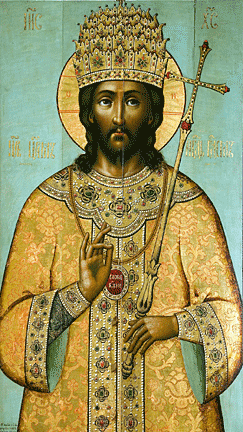 Novgorodian
icon painters interpreted other themes and motifs, including the motif
of the wide-open eyes and treating the face, the hair and the beard, as
well as the highlights, distinctly in the manner of a draftsman. Another
motif is the peculiar pointed beard, often called a “moist” beard
because it looks as if the Christ just stepped out of the bath. Also,
Novgorod icons had one special feature in common with Western religious
art: the painters often depicted scenes from the history of their city
and from contemporary life. Novgorodian
icon painters interpreted other themes and motifs, including the motif
of the wide-open eyes and treating the face, the hair and the beard, as
well as the highlights, distinctly in the manner of a draftsman. Another
motif is the peculiar pointed beard, often called a “moist” beard
because it looks as if the Christ just stepped out of the bath. Also,
Novgorod icons had one special feature in common with Western religious
art: the painters often depicted scenes from the history of their city
and from contemporary life.
Simon Ushakov, a contemporary of Rembrandt, was the last great master of
Russian icon painting. Traditionalists favored icons with their
two-dimensional style. Ushakov, on the other hand, sought to produce the
illusion of real space and of fully rounded figures. He achieved
ultimate perfection in suggesting plastic form by means of light and
shade in the field of tempera painting.
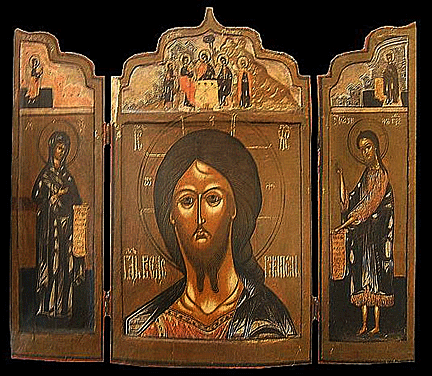 Another
feature of the icons painted by followers of Ushakov is the introduction
of landscape into their images. In Western art, landscapes first
appeared about 1400 as a motif derived from the Song of Solomon. This
motif soon became popular, and the painters of the Czar’s workshop
adopted it. An icon by Nikita Pavlovets shows the Virgin arrayed in
gorgeous robes, holding the crowned Child, while Angels are placing a
crown on her own head–yet another motif adopted from Western Madonna
paintings. Though she’s painted in flat areas, the ground behind her is
shown in central perspective, like a view of a contemporary garden. Another
feature of the icons painted by followers of Ushakov is the introduction
of landscape into their images. In Western art, landscapes first
appeared about 1400 as a motif derived from the Song of Solomon. This
motif soon became popular, and the painters of the Czar’s workshop
adopted it. An icon by Nikita Pavlovets shows the Virgin arrayed in
gorgeous robes, holding the crowned Child, while Angels are placing a
crown on her own head–yet another motif adopted from Western Madonna
paintings. Though she’s painted in flat areas, the ground behind her is
shown in central perspective, like a view of a contemporary garden.
The icons produced by painters attached to the Czar’s Armory inspired
many other workshops, both elsewhere in Moscow and particularly in the
so-called painters' villages of Khalui and Palekh. Multi-figured
compositions, which had been introduced as early as the 16th century,
now served to expand the artist's imagination.
<
Back to Antiques Archives
Next Article > |
